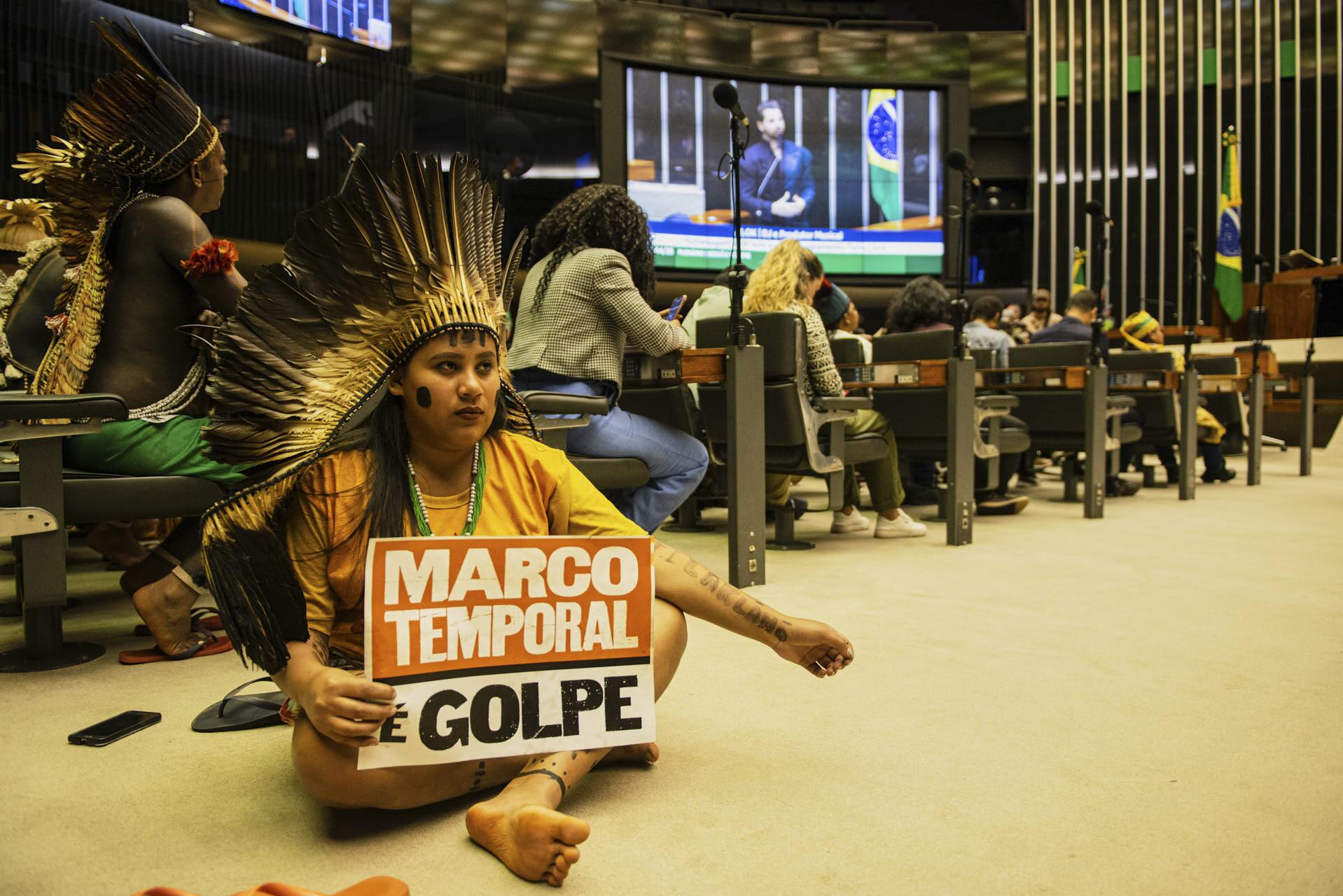The pace of decisions made in the halls of government in Brasília doesn’t keep pace with the burning needs of the children and youth of the Xokleng people, whose lives continually fluctuate between feelings of fright and some degree of hope. In the Ibirama-Laklãnõ Indigenous Territory, 15 miles from the city of José Boiteux in the Upper Itajaí Valley, in the southern state of Santa Catarina, Xokleng families fear that “the white people who are debating the ‘marco temporal’ [historic cutoff point] will doom their children’s lives.” On August 30, Brazil’s Supreme Court will resume its examination of the so-called cutoff thesis—the argument that Indigenous peoples only have the right to their lands if they can prove they were occupying them on October 5, 1988, the date Brazil enacted its newest constitution—a proposition that deliberately disregards the fact that many Indigenous peoples were either expelled from their lands or forced to flee when mortally threatened by non-Indigenous invaders. On June 7, 2023, Supreme Court Justice André Mendonça, appointed by former president Jair Bolsonaro, delayed voting, despite the urgencies of Xokleng children. For the Xokleng, life doesn’t take breaks, and these Indigenous people are the only ones capable of protecting their children in a country that has witnessed centuries of racism, through both the extermination of bodies and the erasure of rights. The Supreme Court decision will define not only the future of the Ibirama-Laklãnõ Indigenous Territory but the future of all Indigenous lands in Brazil. Moreover, it will define the future of all children, including non-Indigenous children, because our ability to grapple with a mutating climate and its devastating impacts depends on the conservation of Indigenous territories. This ruling is not just about the Xokleng or Indigenous peoples alone—it is about humanity.
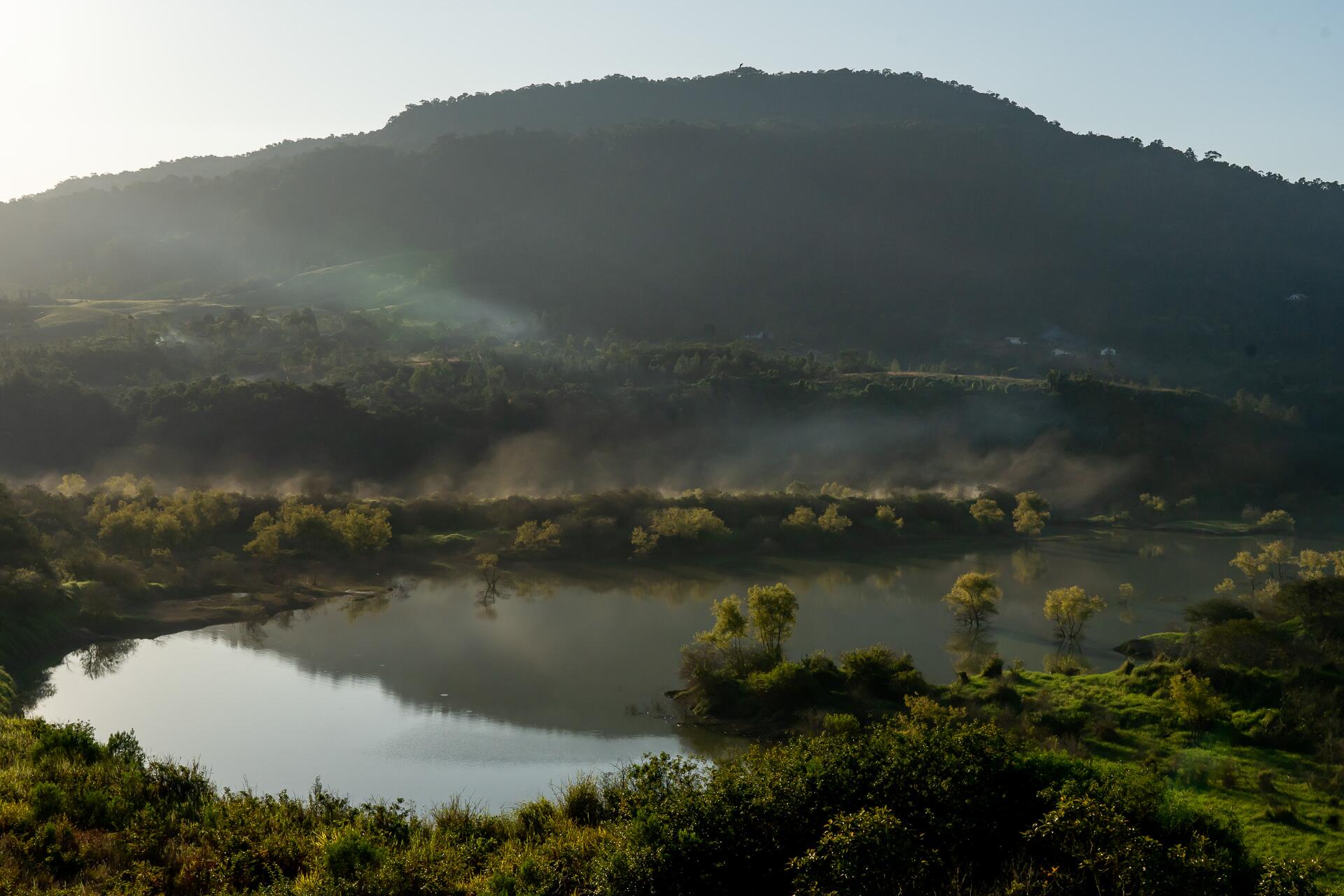
View of the Hercílio River near the Norte dam in the Ibirama-Laklãnõ Indigenous Territory, the central focus of the Supreme Court’s ruling on the so-called historic cutoff thesis
Two scenes, one same threat.
At first, the darkness of night; then dawn breaks amid thick fog. In the village of Figueira, in Ibirama-Laklãnõ Indigenous Territory, children begin their day before sunrise, when they board a municipal bus to school. Jostling along a bumpy, winding road, they ride 15 miles every day to Rio Denecke, a public school in the municipality of Vitor Meireles. Of the 45 students enrolled there, 35 are Indigenous. Even so, the principal prohibits any “political” discussions, like talk about the historic cutoff thesis.
Elsewhere in the territory, at Laklãnõ Indigenous K-12 School, Xokleng teens are lying down on the cement slab of the sports court, a facility with no walls or roof. The moon is full, and it is 54 degrees Fahrenheit. Sometimes far apart, other times their bodies close together, girls and boys reenact the genocidal violence that generations of their people store in their memories. Organized by the students with the help of teaching staff, this is a reenactment of attacks by bugreiros, the mercenary killers of Indigenous people who were paid by colonizers, European immigrants, and the government. These open wounds were left by the encounter of Indigenous and white people during the colonization of southern Brazil, which intensified in the 1850s, and then by the confinement of these Indigenous people to an area of some 150 square miles[DG1] , starting in 1914—the date the Xokleng Laklãnõ group agreed to establish friendly relations with the non-Indigenous, through the intermediation of Brazil’s former Indigenous agency, known as the Indian Protection Bureau. More than a century later, memory forms a bridge between hatred in the past and racism today.
SUMAÚMA observed the daily routine of the children and teens at schools where young Xokleng study; we also spoke with their teachers about how the lives of this generation have been affected by the controversy surrounding the historic cutoff thesis. The nagging fear that their children might die in some kind of ambush keeps parents awake at night.
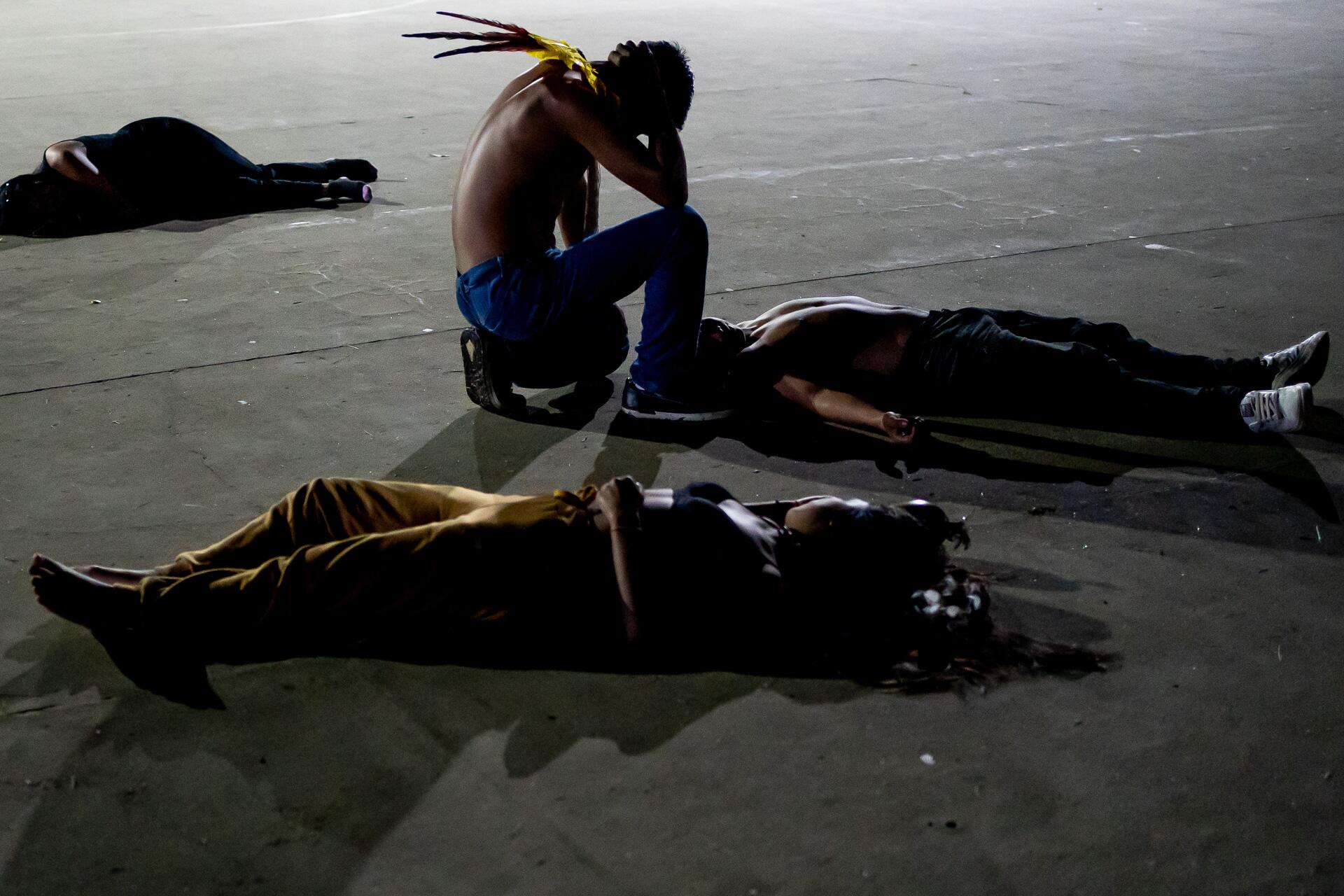
Xokleng youth at Laklãnõ Indigenous K-12 School reenacting attacks on their ancestors by mercenary killers of Indigenous peoples
On the teenagers’ stage, bodies easily sliced open
To lend greater veracity to the reenactment of atrocities experienced by their ancestors, the actors playing the part of militiamen throw party snaps on the ground and run back and forth, screaming and hollering. Meanwhile, those portraying Indigenous people weep in despair as they clutch the bodies of their slaughtered relatives. In classes on Xokleng culture, high school students at Laklãnõ Indigenous K-12 School learn that pistols and shotguns were not the only weapons used by militiamen. That’s why some carry sticks so that in the dark of a night warmed by a campfire, they can simulate struggles and attacks with swift, agile movements. After the initial onslaught, when the echo of gunshots through the Atlantic Forest brought panic to the students’ ancestors, machetes came next. “First, we would fire a few shots. The rest was done with machetes. Bodies are like banana trees, easy to cut. We sliced off their ears; each pair fetched a price. Sometimes, to show them off, we’d bring some women and children along,” said Ireno Pinheiro, a bugreiro, or paid killer of Indigenous people, in a 1972 interview with the anthropologist Sílvio Coelho de Castro.
In these same classes, students also learned the story of an Indigenous girl adopted by a German family in 1908 and subsequently tormented by memories of these bloody episodes. This story was recounted by Luisa Tombini Wittmann in the book O Vapor e o Botoque: imigrantes alemães e índios Xokleng no Vale do Itajaí/SC (1850-1926) [Steamships and mouth plates: German immigrants and Xokleng Indians in Itajaí Valley, Santa Catarina (1850-1925)], published by Letras Contemporâneas. As the child told her adoptive mother, while she recognized that her new family had treated her well, she could never forget what happened to her that night: “My mother always comes to me, her throat slit, and shows me my little brother, cut to pieces. My brother Junvégma always comes and sings to me. But when I wake up in the morning, they’re no longer there, and I have no one but you.”
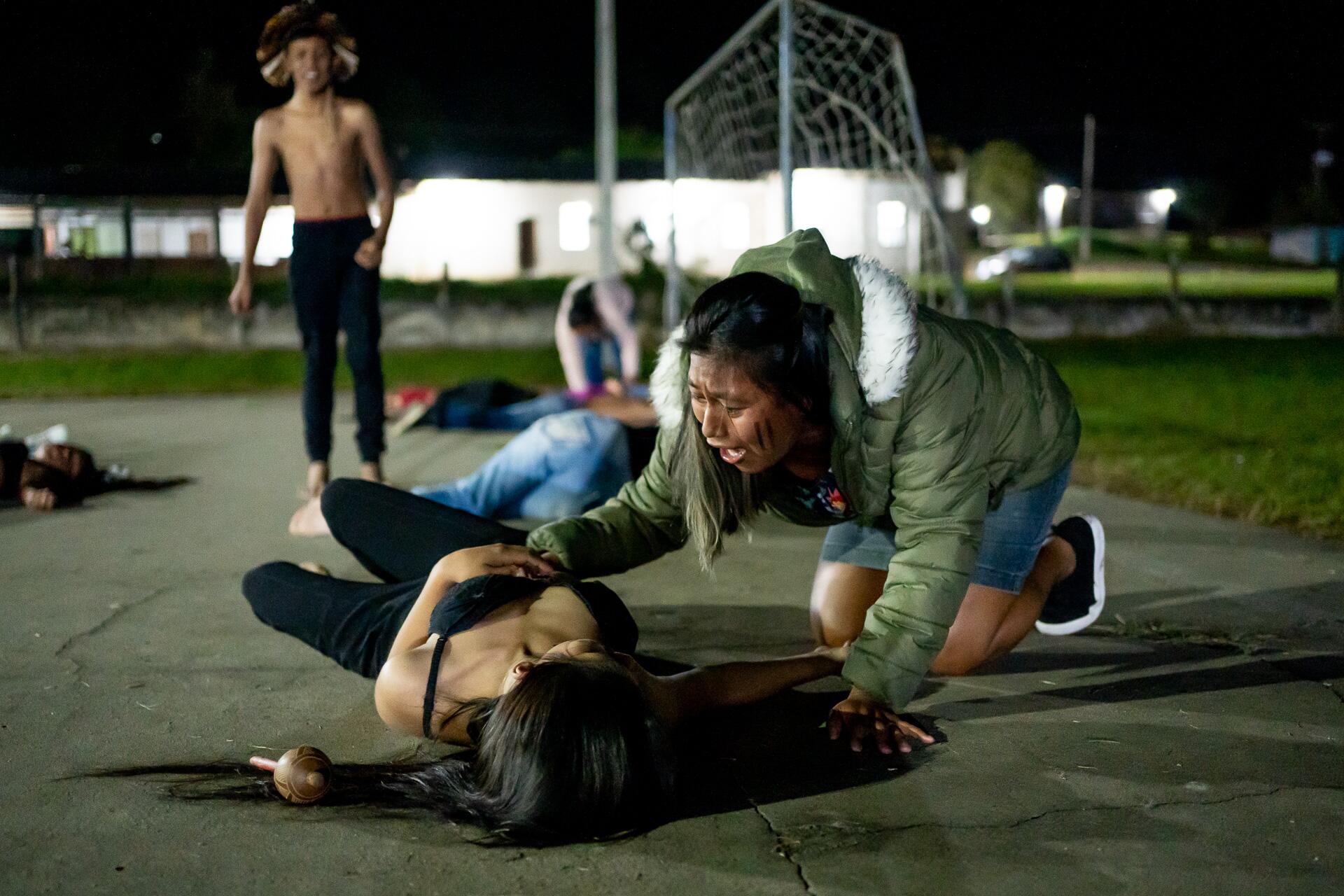
High school students lend veracity to the pain of the past, using theatrical performance to portray atrocities and bloody attacks perpetrated against their ancestors
On the Xokleng’s bare stage, no curtain ever drops. The audience of students and teachers knows there are many more acts to follow. SUMAÚMA was invited to watch a performance by the young students, after having a conversation with the educators, all members of the Xokleng people. Like the students, they speak of unhealed wounds. “When I was a child, I got goose bumps when I heard my elders tell these stories. Sometimes I’d cover my head with my hands, scared a white man would come and cut off my ears. Today, I’m in favor of not hiding anything, because this is part of our existence,” says Carli Caxias Popó, a history teacher. Her colleagues know that much has been lost, like the ritual initiation into adulthood. In the case of young girls, a band of embira fibers was tied around their left leg and, as they grew, the bands would be changed during rituals involving medicinal herbs and bathing. Young boys had their lips pierced to insert a lip plate, which was gradually replaced by ever larger sizes, until the boy reached adulthood and could decide when to quit enlarging the hole. This adornment on their lower lips earned the Xokleng people the nickname botocudos, from botoque, or lip plate. “I remember my great-grandfather and his piercing. When I was little, I didn’t pay much attention, but now I talk to my students about it, so they’ll value our language and customs,” says Elaine Kozicla Patté, a teacher of Xokleng.
Vacla Bela Camlem, a cultural advisor, sees the school as a space where the Xokleng people can reaffirm and value their ethnicity. “Our role is to show that this whole struggle for the demarcation [legal recognition] of our lands is not new. It traces back through our parents, grandparents, great-grandparents. In June, when the Supreme Court voted on it, we took the children and gave them lessons so they’d understand the real reason we were there in Brasília.”
Copacam Tschucambang, a teacher of early primary grades, has great respect for the function of memory in imagining a possible future: “Our students reflect fear, but they also have hope. We know it’s a hard age, but they need to observe this moment, because they will be our future leaders.”
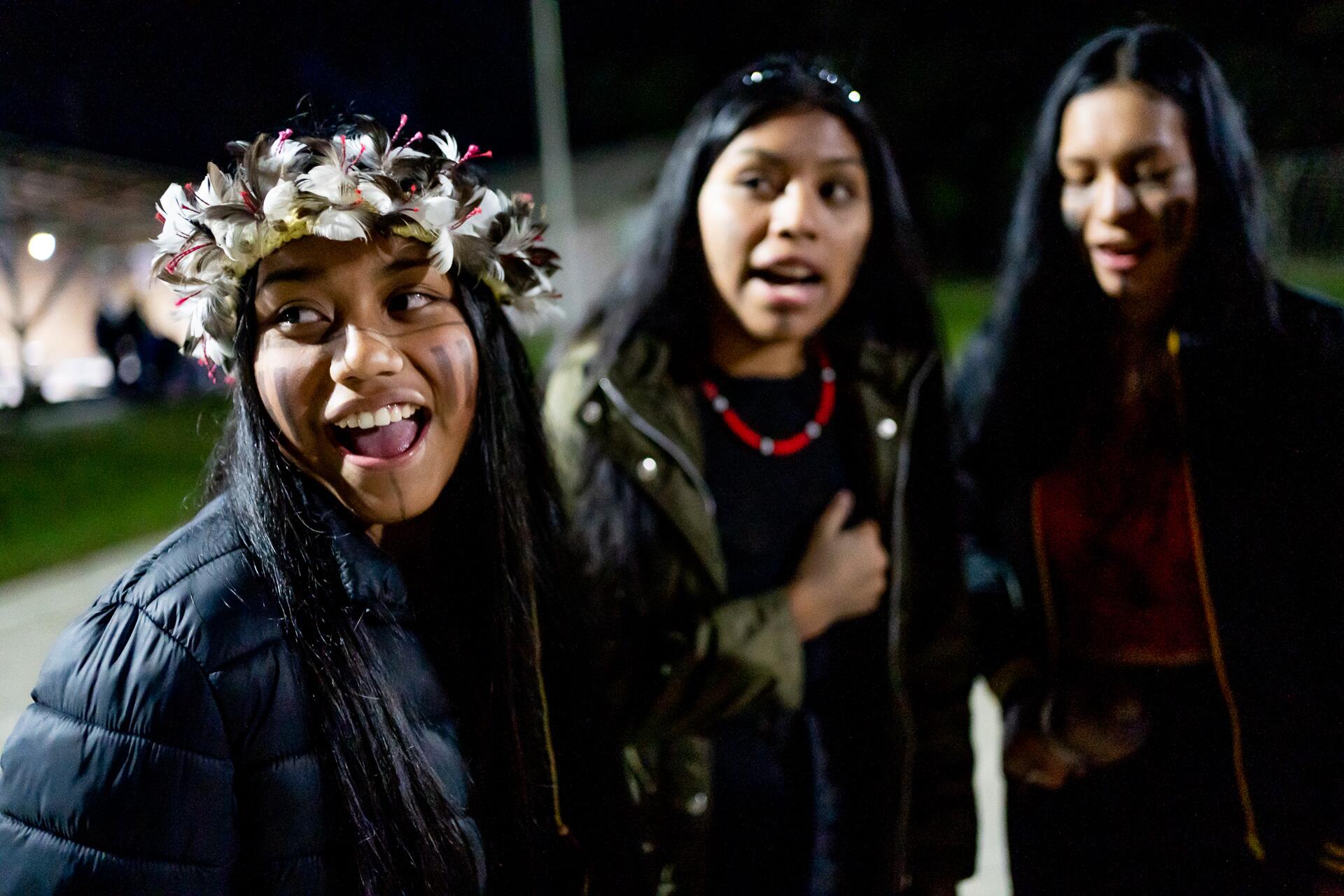
Xokleng teens get ready to dance after a reenactment held in remembrance of the deaths suffered by their people and the scars that still remain
Anderson Vanhpõ Kluge, likewise a teacher, points out that music, song, and theater are part of Xokleng spirituality and enable his people to draw a link between the spiritual and the holy. “Through cultural expressions, our students find a way to connect with their ancestors. Out of prejudice or ignorance, white people say we have no culture. We know that is false.” While the young teacher doesn’t specifically cite the author and political leader Davi Kopenawa Yanomami, his words from the book The Falling Sky are like an arrow aimed at the same target: “Yet I had my account drawn in the white people’s language so it could be heard far from the forest. Maybe they will finally understand my words and after them their children and later yet the children of their children. Then their thoughts about us will cease being so dark and twisted and maybe they will even wind up losing the will to destroy us. If so, our people will stop dying in silence, unbeknownst to all, like turtles hidden on the forest floor.”
A trip with their hearts in their throats
At Ruth Caxias Popó’s home, in the village of Figueira, the day begins before 5:30 AM, when she is already rousing awake her six-year-old son and eight-year-old grandson, who is on the autism spectrum. When the boys catch the bus in front of their house at 6:00 AM, the SUMAÚMA team joins them on their trip. Jussara Reis dos Santos, vice-president of the Laklãnõ Indigenous Territory, climbs aboard too. The children are leery of the strangers on the bus.
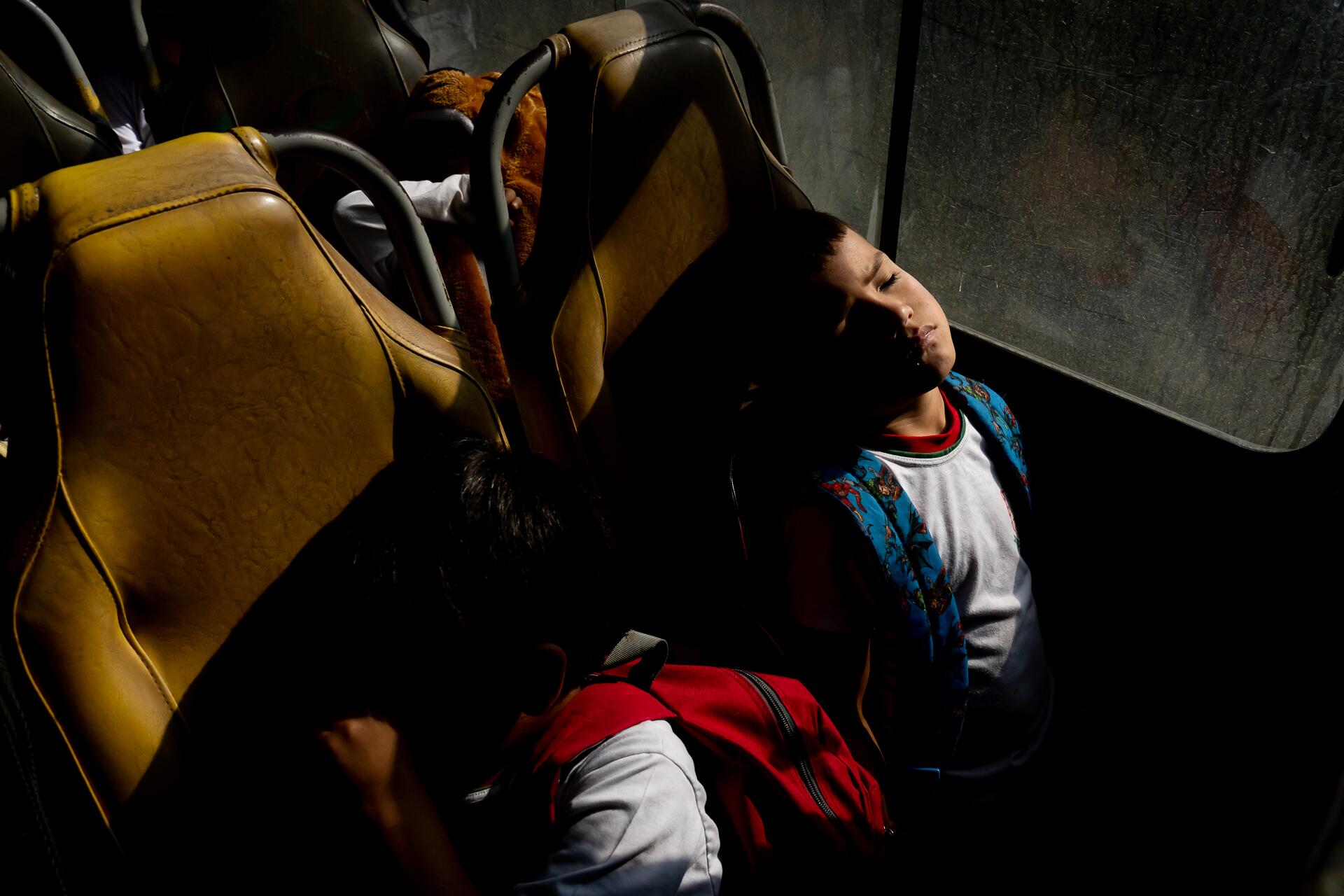
Children living in the Indigenous Territory take the bus every day to Rio Denecke public school. Their parents fear they might suffer some kind of ambush along the way
Almost nothing is visible in the dark morning hours. There are no bus stops along the way where the children can wait safely for their ride. Jostling along the bumpy, winding road, the bus picks up its passengers. There are no staff to help the youngsters get in or out, nor are there any seat belts. Almost all of the children are rocked to sleep by the sway of the bus, provided by the city of Vitor Meireles. For the vice-president Jussara, they are in urgent need of a safe bus for student transportation.
None of the adults in the village feels comfortable about the bus ride. “Our hearts are in our throats when they’re on the bus. It’s a dirt road, when it rains it’s dangerous, there’s a 60-foot bridge over the Denecke River that shakes with the force of the water. Besides, there are a lot of trucks loaded with pine logs. We worry about an accident,” says Ruth. The physical perils of the road heighten the anxiety of people who live in fear of the consequences of a steady stream of strangers on their Indigenous lands. “Our territory encompasses four municipalities, and there are no entryways or gates guarding the entrances. In fact, we have white neighbors who are involved in the historic cutoff polemic, and that worries us,” says Karim Nidli. Her husband, Jaime de Almeida, thinks the school doesn’t guarantee the children’s safety. “The nearest neighbor has a curing shed for tobacco leaves, an angry dog, and he drives a tractor. Out back, there’s a river and a bridge. No matter how much the teachers keep an eye out, the children are vulnerable,” he explains.
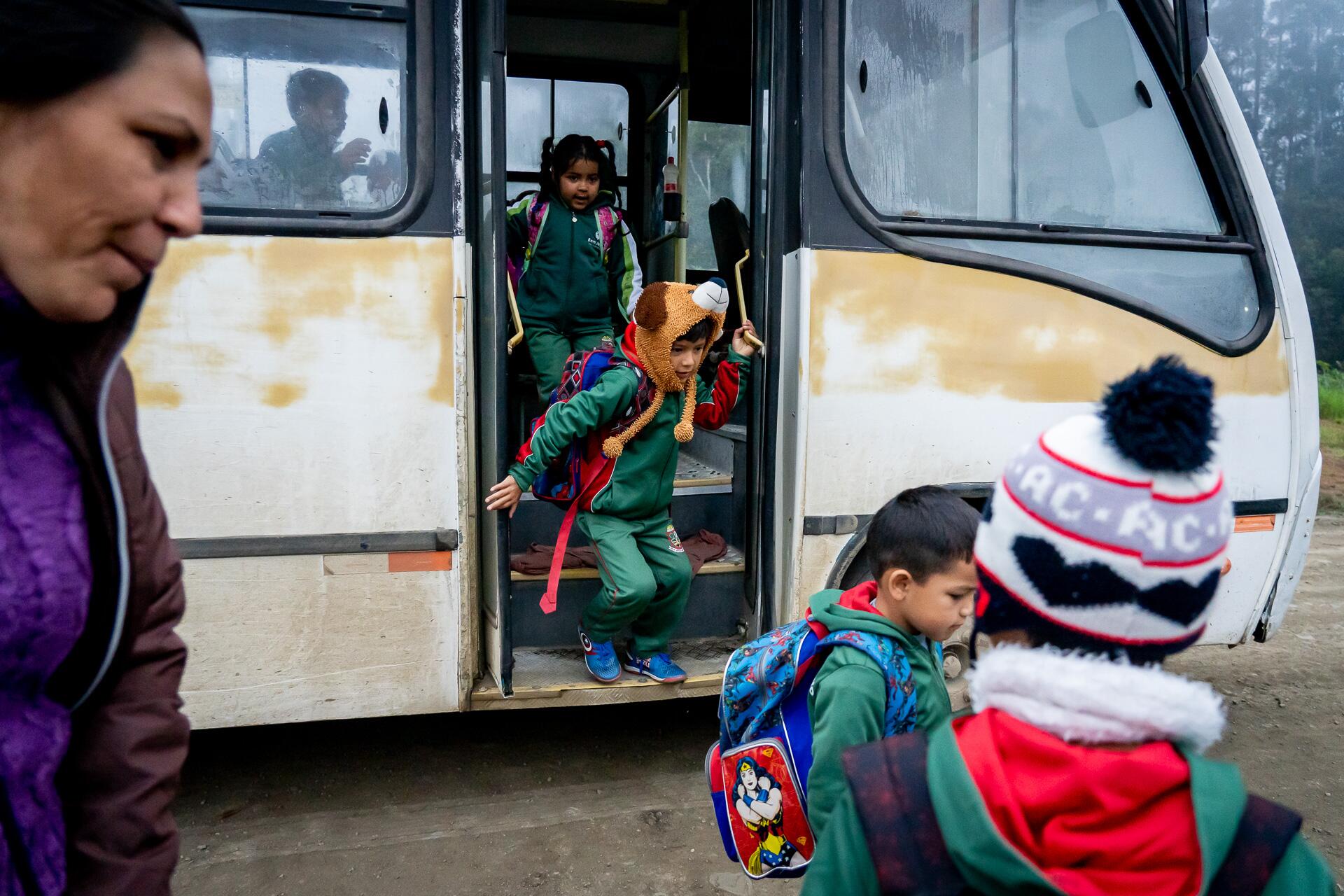
When the children arrive at school, they are met by their teachers, three of whom are Xokleng and greet the students in their native language
The children arrive at the school excited. They are given a snack and head to their classrooms. Three of the five teachers are Xokleng, and they are greeted in their native tongue. The other two, like the principal, Ilma Watras, descend from German immigrants. Ilma says she is concerned about low attendance on the part of some students: “We’ve scheduled a meeting with Indigenous leaders to address the matter. We know winter is cold and rainy, but a child can’t miss several days in a row,” she says. When it comes to the most pressing issue for Xokleng families, the right to land, the principal says the school steers clear. “The historic cutoff point isn’t discussed here, just like other political matters. This is a place of knowledge, and our commitment is to serving children, whether they are Indigenous or not,” says Ilma, who holds a graduate degree in special education and teacher training.
But Xokleng children seem unaware of this rule. Whenever they return from a civic action, they hurry to tell the principal what they’ve done: “I went to Brasília.” Ilma says she doesn’t shut down the conversation but just replies good-humoredly that she wasn’t invited. “We’ll invite you next time,” the children respond. Classes end at 11:30 AM. On their way home, the children stare through the cracked bus windows at brick homes, evangelical churches, and clothes hanging on the line.
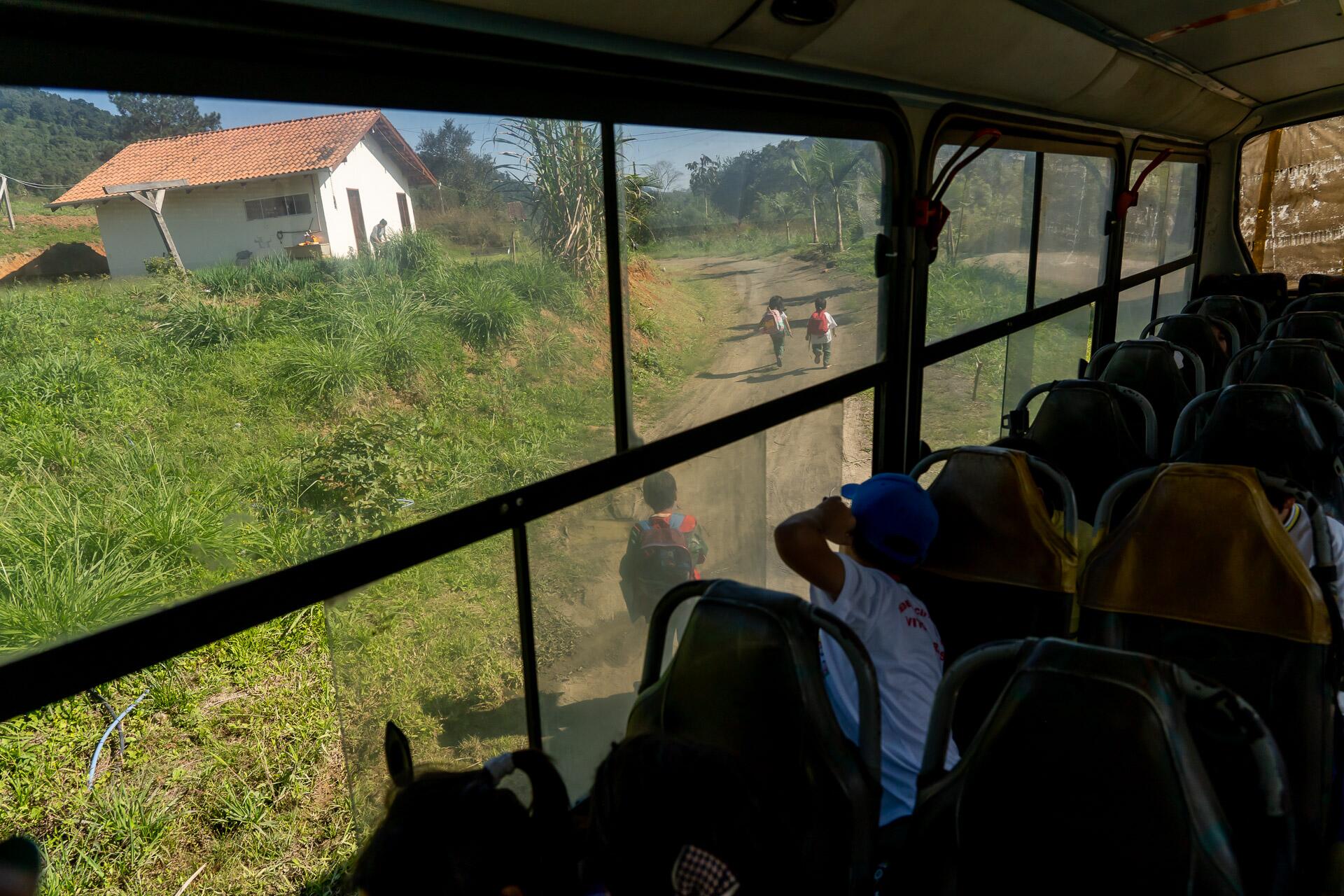
On their way home, the young Indigenous students stare out the windows at brick houses, evangelical churches, and clothes hung out to dry. Their school has prohibited any discussion of the cutoff thesis
Every man for himself and the Xokleng for all
Two thousand miles separate the Xokleng, in the Upper Itajaí Valley, site of the Itajaí-Açu River, in Santa Catarina state, from the Munduruku people, who live along the banks of the Tapajós River in the northern state of Pará. The distance seems short, however, when you see Xokleng children playing under the watchful eye of their elders, far from river and trees. It is almost imperative to recall what the writer Daniel Munduruku once said: “I don’t remember my father or mother forcing me to be something other than what I was. And what was I? A child. It was the only thing I had to be. So I didn’t have to be anything else.”
For Xokleng girls and boys, the challenge lies in learning how to be a child, while their people still wait—as they have for decades—for the demarcation of their lands, as if they lived in permanent exile or had been deported to a sliver of ground. “The lack of space means generations have been deprived of the chance to enjoy aspects of their traditions, like living with their grandparents and learning the language from their parents. Furthermore, they grow up feeling the effects at a cultural and material level—how to do subsistence farming, build their homes, receive knowledge about medicinal plants, and learn about the spirits of the woods,” says Clovis Antonio Brighenti, who holds a PhD in history from the Universidade Federal de Santa Catarina and is professor at the Universidade Federal da Integração Latino Americana (Unila). The professor rejects the adage “the wheels of justice turn slowly but grind exceedingly fine,” because the history of the Xokleng people is marked by ruptures and losses, such as another tragic landmark: the military government’s construction of the Barragem Norte dam in 1970.
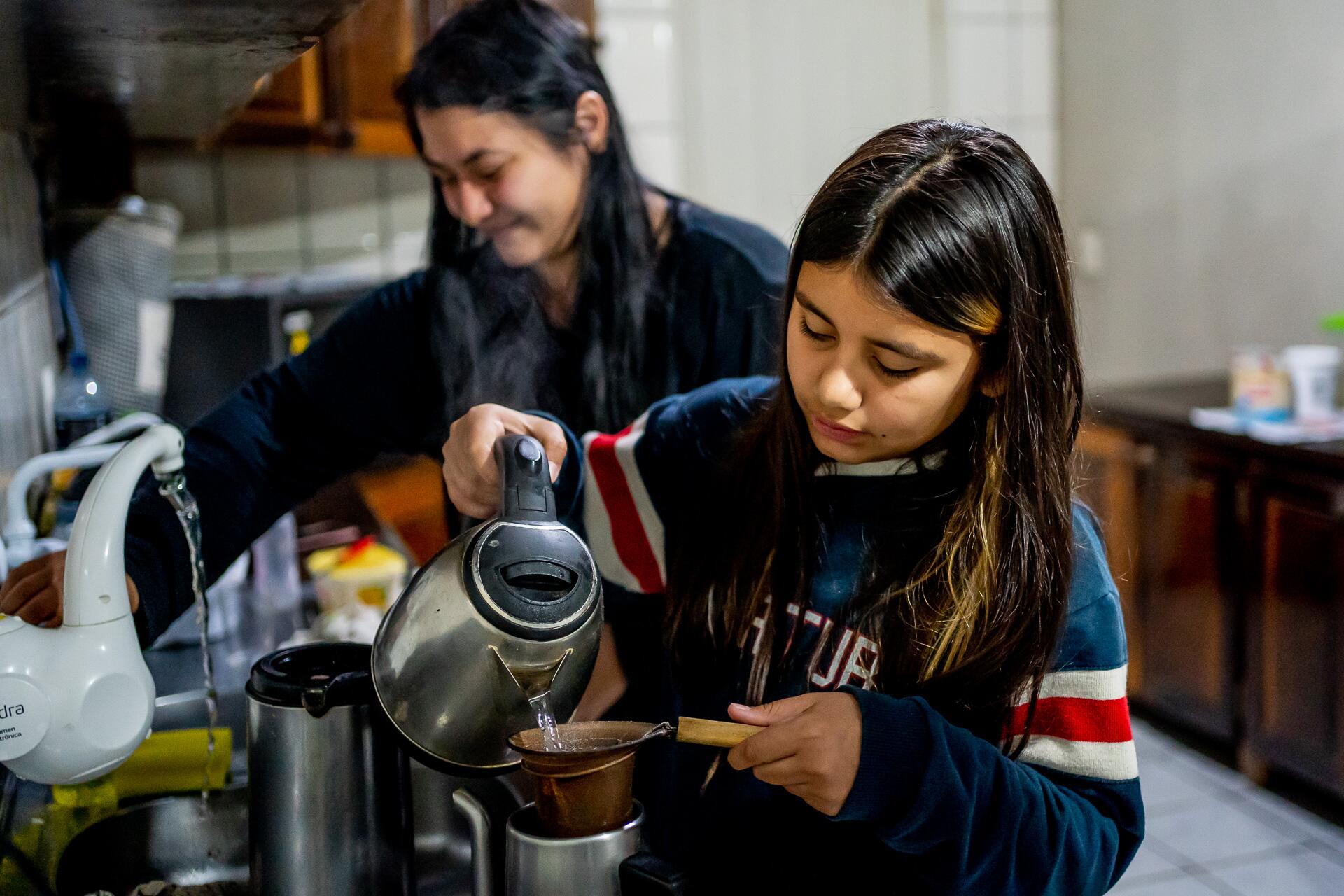
Thaira Pripra with her 10-year-old daughter Hadja Amedo Pripra Patté. For the Xokleng, the community shares responsibility for looking after all the children
“My whole generation was impacted and now my daughter’s generation is as well. The river was shallow before, and you could learn to swim. After the dam was built, the water was deeper, and children died. Because of the flooded area, our family was separated, and we grew up far from our aunts, uncles, and cousins, in different villages,” says Thaira Pripra, 27, who is majoring in psychology at the Universidade Federal de Santa Catarina (UFSC). The future psychologist recognizes the tensions that have been sparked by land disputes. “Our children don’t play by themselves, away from their houses. We grow up knowing we can’t expose ourselves to risk, and with time we have learned to act.” For Thaira, the violence they have suffered has strengthened their bonds. “If there’s one thing that hasn’t caught on among the Xokleng, it’s ‘everybody takes care of their own child,’ as white people say. We have a different view of family structure; biological character is community-based, focused on the collective. We are all responsible for our children,” she says.
Thaira is the mother of Hadyja Amedo, 10, who is always with her, even living with her in a university housing unit known as the maloca, or Indigenous communal hut. Hadyja says she’s going to study law so she can defend the Xokleng people. On her Instagram page, which is monitored by her mother, the girl introduces herself as a ‘young Xokleng leader.’ In 2020, the Military Police threw pepper spray in her daughter’s eyes during an Indigenous mobilization in Brasília, baptizing her to the struggle. “There were tears and distress, but we learned a lesson about what can happen when we take part in movements for our rights,” says Thaira.
The reaffirmation of Indigenous identity comes at a price. In April, Eduarda Wanhkyl Kágfej de Lima Tschucambang, 15, was at an agricultural show in Rio do Sul, a city in Itajaí Valley, representing her municipality of José Boiteux, when she heard someone say “Indians should evolve and leave their huts, just like white men left their caves.” Hurt by the white man who had recognized her Indigenous features—along with her earrings and a bracelet with ethnic graphics—Eduarda stopped handing out leaflets inviting people to a traditional party and decided to leave. Her mother, the Indigenous teacher Josiane Uglon, says it was ten at night when her daughter came back crying and went straight to her room. The case was reported to the federal Public Prosecutor’s Office.
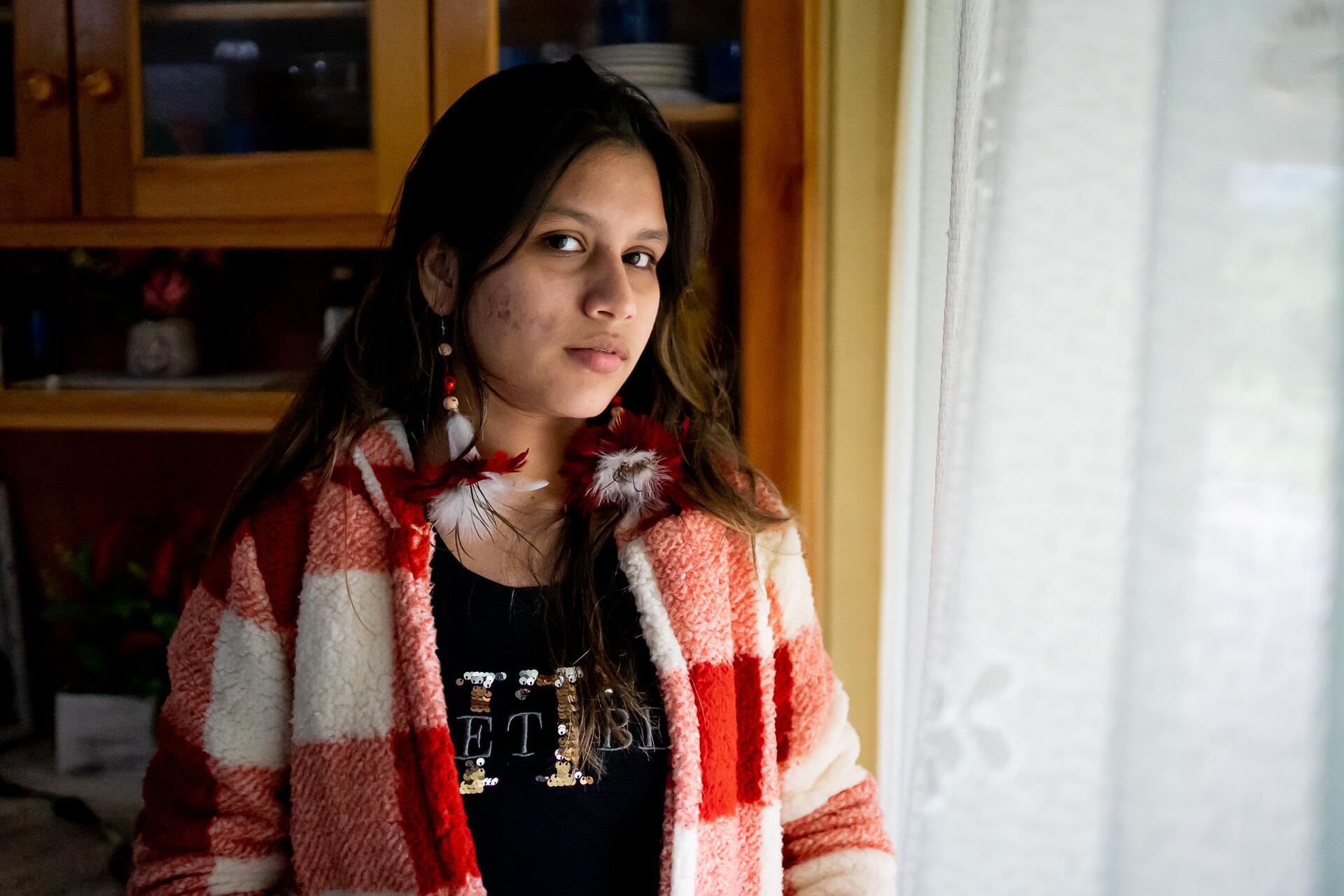
Fifteen-year-old Eduarda Wanhkyl de Lima Kágfej was the victim of racism. At a farm show, she heard a white man say that “Indians should evolve and leave their huts”
Eduarda’s father, former cacique Canan Tschucambang, went to City Hall to demand an explanation from José Boiteux Mayor Adair Antonio Stollmeier (Progressives party). According to the press office for the city of José Boiteux, “a statement was issued expressing regret about what happened and advising the family to take action.” Fearing harassment, the family opted to send the case to the Santa Catarina State Indigenous Peoples Council rather than report it to the police. “Agribusiness is very powerful in our region, and it has people at all levels of society. I’m afraid the same thing would happen to us as you see happening around here, with the victim being made into the perpetrator,” Canan says.
This role reversal, where history turns victims into culprits and robs them of their rights and dignity, is the biggest fear for the Xokleng and the other Indigenous people who are once again putting their children’s future in the hands of the courts—even though they know only the Xokleng will protect young Xokleng.
Spell check (Portuguese): Elvira Gago
Translation into Spanish: Meritxell Almarza
English translation: Diane Whitty
Photography editing: Lela Beltrão
Page setup: Érica Saboya
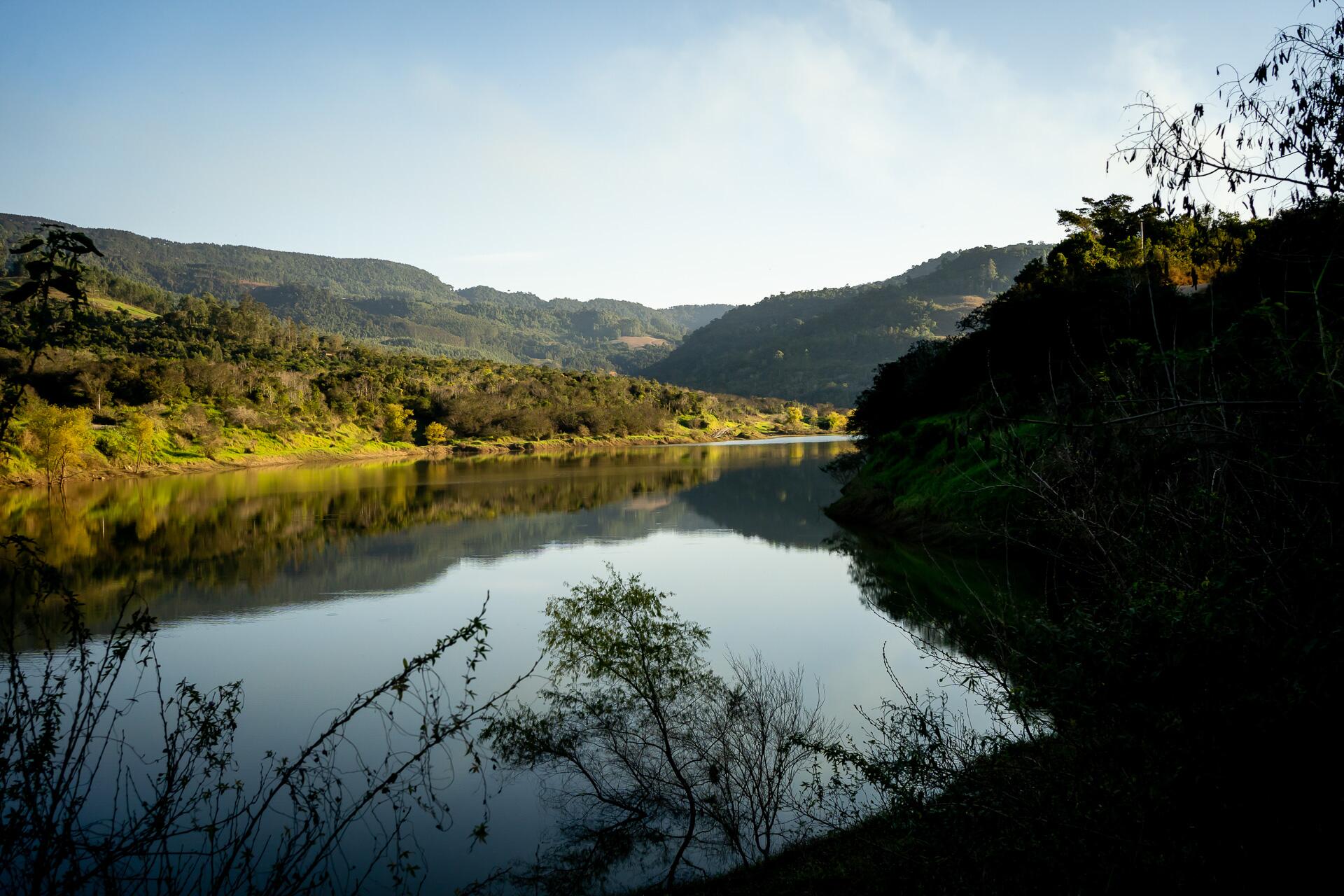
Scenery in the Ibirama-Laklãnõ Indigenous Territory: the future of the Xokleng people lies in the hands of Brazil’s Supreme Court




